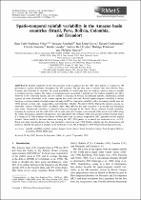Mostrar el registro sencillo del ítem
Spatio-temporal rainfall variability in the Amazon basin countries (Brazil, Peru, Bolivia, Colombia, and Ecuador)
| dc.contributor.author | Villar, J.C.E. | |
| dc.contributor.author | Ronchail, J. | |
| dc.contributor.author | Guyot, J.L. | |
| dc.contributor.author | Cochonneau, G. | |
| dc.contributor.author | Naziano, F. | |
| dc.contributor.author | Lavado-Casimiro, W. | |
| dc.contributor.author | De Oliveira, E. | |
| dc.contributor.author | Pombosa, R. | |
| dc.contributor.author | Vauchel, P. | |
| dc.date.accessioned | 2019-07-27T02:09:28Z | |
| dc.date.available | 2019-07-27T02:09:28Z | |
| dc.date.issued | 2009-09 | |
| dc.identifier.uri | http://repositorio.senamhi.gob.pe/handle/20.500.12542/72 | |
| dc.description.abstract | Rainfall variability in the Amazon basin (AB) is analysed for the 1964-2003 period. It is based on 756 pluviometric stations distributed throughout the AB countries. For the first time it includes data from Bolivia, Peru, Ecuador, and Colombia. In particular, the recent availability of rainfall data from the Andean countries makes it possible to complete previous studies. The impact of mountain ranges on rainfall is pointed out. The highest rainfall in the AB is observed in low windward regions, and low rainfall is measured in leeward and elevated stations. Additionally, rainfall regimes are more diversified in the Andean regions than in the lowlands. Rainfall spatio-temporal variability is studied based on a varimax-rotated principal component analysis (PCA). Long-term variability with a decreasing rainfall since the 1980s prevails in June-July-August (JJA) and September-October-November (SON). During the rainiest seasons, i.e. December-January-February (DJF) and March-April-May (MAM), the main variability is at decadal and interannual time scales. Interdecadal variability is related to long-term changes in the Pacific Ocean, whereas decadal variability, opposing the northwest and the south of the AB, is associated with changes in the strength of the low-level jet (LLJ) along the Andes. Interannual variability characterizes more specifically the northeast of the basin and the southern tropical Andes. It is related to El Niño-Southern Oscillation (ENSO) and to the sea surface temperature (SST) gradient over the tropical Atlantic. Mean rainfall in the basin decreases during the 1975-2003 period at an annual rate estimated to be -0.32%. Break tests show that this decrease has been particularly important since 1982. Further insights into this phenomenon will permit to identify the impact of climate on the hydrology of the AB. | en_US |
| dc.format | application/pdf | |
| dc.language.iso | eng | en_US |
| dc.publisher | Wiley Online Library | en_US |
| dc.relation.ispartof | urn:issn:0899-8418 | |
| dc.rights | info:eu-repo/semantics/openAccess | es_PE |
| dc.rights | Attribution-NonCommercial-ShareAlike 3.0 United States | * |
| dc.rights.uri | http://creativecommons.org/licenses/by-nc-sa/3.0/us/ | * |
| dc.source | Servicio Nacional de Meteorología e Hidrología del Perú | es_PE |
| dc.source | Repositorio Institucional - SENAMHI | es_PE |
| dc.subject | Amazon Basin | en_US |
| dc.subject | Andes | en_US |
| dc.subject | Bolivia | en_US |
| dc.subject | Colombia | en_US |
| dc.subject | Ecuador | en_US |
| dc.subject | ENSO | en_US |
| dc.subject | LLJ | en_US |
| dc.subject | PDO | en_US |
| dc.subject | Rainfall regimes | en_US |
| dc.subject | Rainfall variability | en_US |
| dc.subject | South America | en_US |
| dc.subject | Amazonia | |
| dc.subject | Lluvia | |
| dc.title | Spatio-temporal rainfall variability in the Amazon basin countries (Brazil, Peru, Bolivia, Colombia, and Ecuador) | en_US |
| dc.type | info:eu-repo/semantics/article | en_US |
| dc.identifier.isni | 0000 0001 0746 0446 | |
| dc.description.peerreview | Por pares | |
| dc.identifier.doi | https://doi.org/10.1002/joc.1791 | |
| dc.identifier.doi | https://doi.org/10.1002/joc.1791 | |
| dc.source.volume | 29 | es_PE |
| dc.source.issue | 11 | es_PE |
| dc.source.initialpage | 1574 | es_PE |
| dc.source.endpage | 1594 | es_PE |
| dc.source.journal | International Journal of Climatology | es_PE |
Ficheros en el ítem
Este ítem aparece en la(s) siguiente(s) colección(es)
-
Artículo científico [166]









